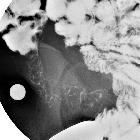Cobblestone appearance (hollow viscera)

Cobblestone
appearance (hollow viscera) • Cobblestoning - terminal ileum - Ganzer Fall bei Radiopaedia

Teenager with
chronic right lower quadrant pain. Spot images of the terminal ileum from an upper GI small bowel follow through show diffuse luminal narrowing of the terminal ileum associated with mucosal ulceration along with a nodular and cobblestone appearance to the terminal ileum.The diagnosis was Crohn disease.

Crohn disease
• Crohn disease - cobblestone appearance (gross pathology) - Ganzer Fall bei Radiopaedia

Eosinophilic
gastroenteritis • Eosinophilic gastritis - Ganzer Fall bei Radiopaedia

Lissencephaly
type II • Cobblestones (photo) - Ganzer Fall bei Radiopaedia
Cobblestoning (having a cobblestone appearance) can occur in a number of hollow organs with mucosa, most commonly the bowel, in the setting of Crohn disease.
Longitudinal and circumferential fissures and ulcers separate islands of mucosa, giving it an appearance reminiscent of cobblestones.
Cobblestone appearance has been reported in:
- Crohn disease: small and large bowel
- candida esophagitis
- Hirschsprung disease
- eosinophilic gastritis
- duodenitis
- Brunner gland hyperplasia of the duodenum
- nodular lymphoid hyperplasia in duodenal cap
Other disease processes can present with cobblestone-like imaging characteristics.
- intraluminal adhesions of the fallopian tubes on hysterosalpingography
- cobblestone lissencephaly (in the brain)
Siehe auch:
und weiter:

 Assoziationen und Differentialdiagnosen zu Pflastersteinrelief:
Assoziationen und Differentialdiagnosen zu Pflastersteinrelief:


